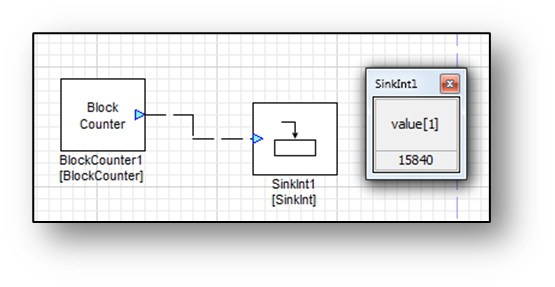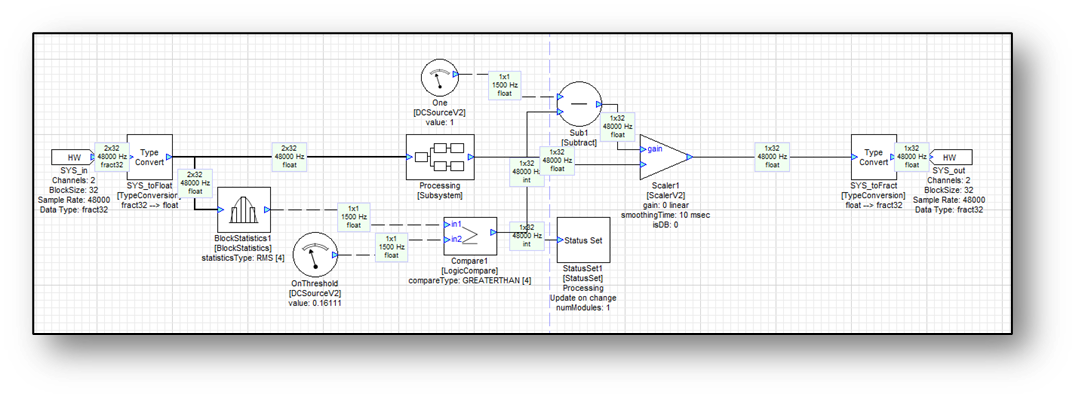Misc
This section contains the following pages:
Most of these modules are used for debugging, and verification during the product development phase. These modules are great for testing the hardware, stimulating conditions, profiling, and adding custom interfacing with the Board Support Package such as GPIO and other (non-audio) input signals. There are also modules in here that help get around the strict data flow of AudioWeaver by manipulating how the data is represented (i.e. samples turn into channels, etc).
Biquad Loading
This module builds virtual biquads in memory with a number of max stages, and a variable that “turns on” the filter function. As data passes through, the mips and memory will update in the server window. This is useful for evaluating what kind of processing works and fits on a target. Set maxStages in the Arguments tab.


Block Counter
This module outputs the number of blocks processed based on the system BlockSize. This source increments for each block called at the hardware defined samplerate. It then outputs this value. This is useful for determining how many blocks get processed in the system, typically for debugging.

Coeff Table
This module is similar to paramSet, except it sends a vectored variable rather than a singular numeric variable. Set the coeffs to be sent to the variable by typing into the properties sheet, then clicking apply. Upon clicking apply, the coefficient data is sent to whatever module lies within the modVar argument.


Counter
This counter module counts at a given interval, with a minimum interval of one msec. This is good for debugging, as it gives a time constant to determine when(in ms) an issue arises.
Cycle Burner
This module is similar to the Biquad loading, except it works in computation cycles per block, and has no inputs or outputs. This is convenient for testing out multiple block sizes and cpu load for the target.
FIRLoading
This module is similar to the Biquad loading, except it is more memory intensive. Use this to determine the amount of FIR modules that can be loaded onto a target.
GPIO
The GPIO module is binary only. It can both accept GPIO signals and send them to the target, based on parameters in the module properties. The sample rate can also be specified. This should match the setup in the BSP. Most target chips will have dedicated GPIO lanes, and will specify how to set it up.
Math Exception
This module replaces NAN and INF with the value specified by the user. This is useful for keeping stability in a system which may require numeric data.
Measurement
This module is used to measure a room based on a periodic output of the input signal. This is used to average the recorded signal into the response buffer. The trigger pin starts the measurement upon changing from 0 to 1. Once the measurement is complete (based on numReps and the length of the signal, L), the trigger is set back to 0.
Param Get
The ParamGet module reads the value of a parameter from an existing module and outputs it on a wire for use elsewhere in the system. Which parameter to output is specified in the module properties, with “name of the module”.“parameter to be output”. An example of this module can be found in ParamSet and ParamGet.
 | ParamGet | Outputs a parameter from a specified module |

Param Set
The ParamSet module does the opposite: it takes an input from the system and sets its value to a parameter of an existing module. The key is that this module can set parameters of any type of module, which eliminates the need to create separate controllable versions of each module. An example of this module can be found in ParamSet and ParamGet.
 | ParamSet | Sets a parameter of a specified module |

Safety Clip
This module clips an incoming signal based off of an external trigger. The clip amount can be specified in the properties. This is used in systems to prevent damage to equipment by digitally clipping loud sources. This usually results in less gain given.
Sample Rate
This module counts the sample and outputs the estimated sample rate of a system. This is useful for debugging samplerate related issues.
Set Wire Properties
This module is used to change wire properties for a more direct handling of audio weaver data values. It works by treating the samples as different block sizes, channels, data type, sample rate, and complexity. The only rule is that the samples in must equal the samples out. For example, at 48k and a block size of 32 stereo signal, that means there are 32 samples every block, or 64 samples per block of stereo information. These 64 samples can also be represented as blocksize=64, one channel. Notice the wire info and SetWireProperties modules in the following design:

While this doesn’t give much advantage in the time domain with standard audio data, this module is especially strong in the frequency domain to handle signal flow.
Status Set
This module can change the “status” of other modules in the design. This is useful for limiting compute cycles during runtime. To bypass a module during runtime, the status set module is given a variable name of where to point, and four controls for the status states: Active, Muted, Bypass, and Inactive. The input takes in an integer signal 1-4, with any other number gets treated as 1. These numbers represent the four states. If this control signal gets bypassed, then the status set module cannot turn itself back on. The diagram below is an example of a very low power “processing” system, which takes advantage of the status set module.

Update Sample Rate
This module updates the sample rate information for wires and modules. It does not change the sample rate. For that, see the FIR Interpolator and Decimator in the “Multirate” folder.
